
Splashes of pale blue Wild Hyacinth (Camassia scilloides) provide welcome mid-May color in the Schulenberg Prairie.

Shooting Star (Primula sect. Dodecatheon) sends up 18" leafless scapes in April and May in a variety of white, pink or magenta, drooping blooms.
 Columbine: (Aquilegia canadensis) blooms in late May at the intersection between the prairie and savannah.
Columbine: (Aquilegia canadensis) blooms in late May at the intersection between the prairie and savannah.
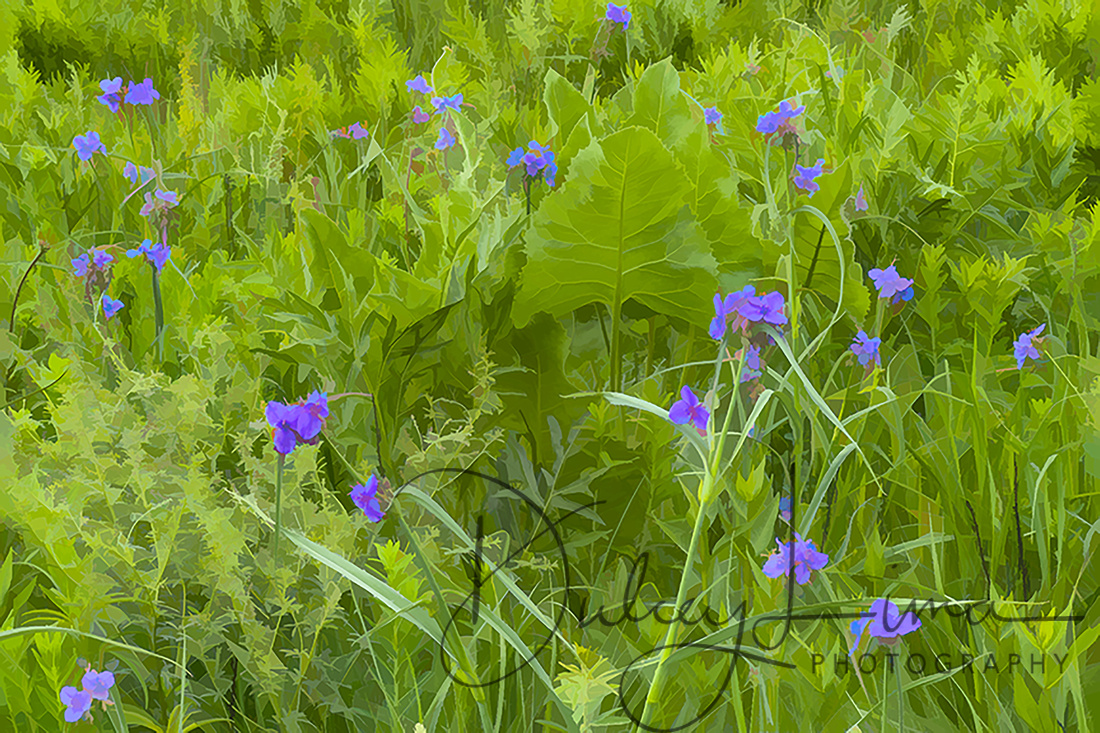 Bright Purple Spiderwort (Tradescantia occidentalis) pops up between the large leaves of Compass Plant and Prairie Dock. The flowers close by mid-day and last only a day.
Bright Purple Spiderwort (Tradescantia occidentalis) pops up between the large leaves of Compass Plant and Prairie Dock. The flowers close by mid-day and last only a day.
 Wild Indigo (Baptisia alba) has pea shaped flowers and joins with Spiderwort to decorate the prairie with tall, white spikes in June.
Wild Indigo (Baptisia alba) has pea shaped flowers and joins with Spiderwort to decorate the prairie with tall, white spikes in June.

As the Baptisia and Spiderwort begin to fade, Pale Purple Coneflowers (Echinacea pallida) take center stage.
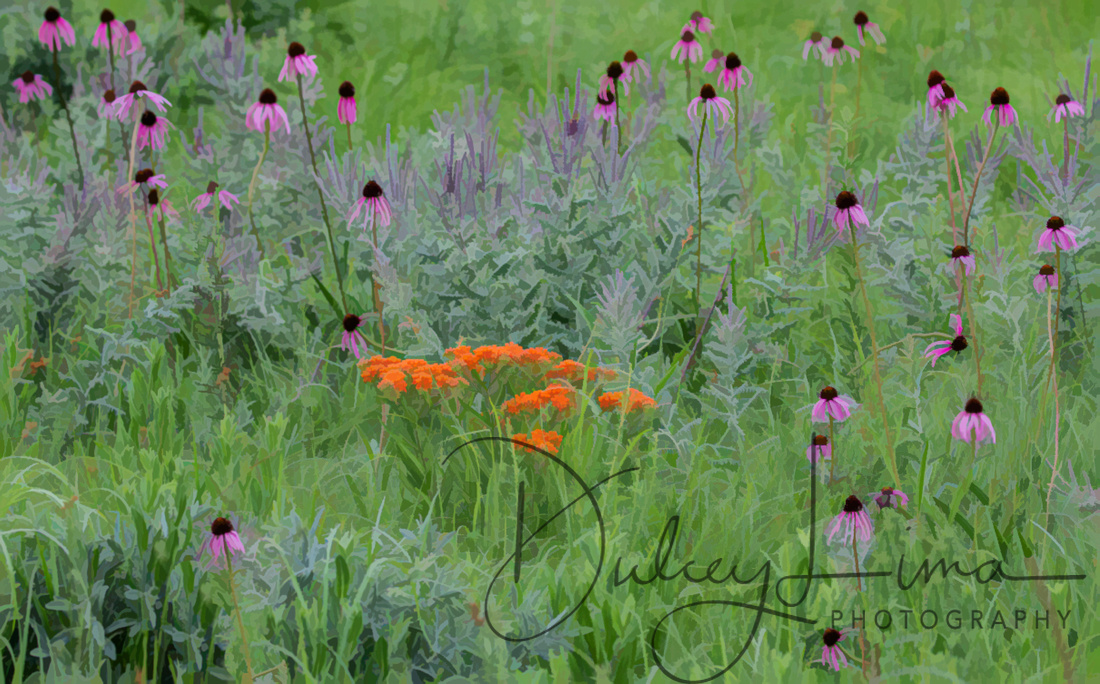
Pale Purple Coneflower (Echinacea pallida), Butterfly Weed (Asclepias tuberosa)
and Leadplant (Amorpha canescens), bloom together in late June, creating a palette of pinkish purple, orange, purple and gray.
 Leadplant (Amorpha canescens) and Butterfly Bush (Asclepias tuberosa) leave the coneflowers behind, creating a bright splash of purple and orange as late Spring transitions to summer in late June.
Leadplant (Amorpha canescens) and Butterfly Bush (Asclepias tuberosa) leave the coneflowers behind, creating a bright splash of purple and orange as late Spring transitions to summer in late June.

The flowers of Purple Prairie Clover (Dalea purpurea) attract honeybees (Genus apis) et al. in late June and early July in the Tallgrass Prairie.
 Leadplant (Amorpha canescens) continues to bloom into July, dotting the prairie with bright purple dollops of color and gray, feathery foliage in contrast to the emerging, white, spiky, spherical blooms of Rattlesnake Master (Ernygium yuccifolium).
Leadplant (Amorpha canescens) continues to bloom into July, dotting the prairie with bright purple dollops of color and gray, feathery foliage in contrast to the emerging, white, spiky, spherical blooms of Rattlesnake Master (Ernygium yuccifolium).

The August prairie brings Plain Gentian (Gentiana alba) and Big Bluestem Grass (Andropogon gerardii) to the fore among the large, rough leaves of Prairie Dock (Silphium terebinthinaceum). A bright blue sky and puffy clouds preside over the Schulenberg Prairie at The Morton Arboretum.
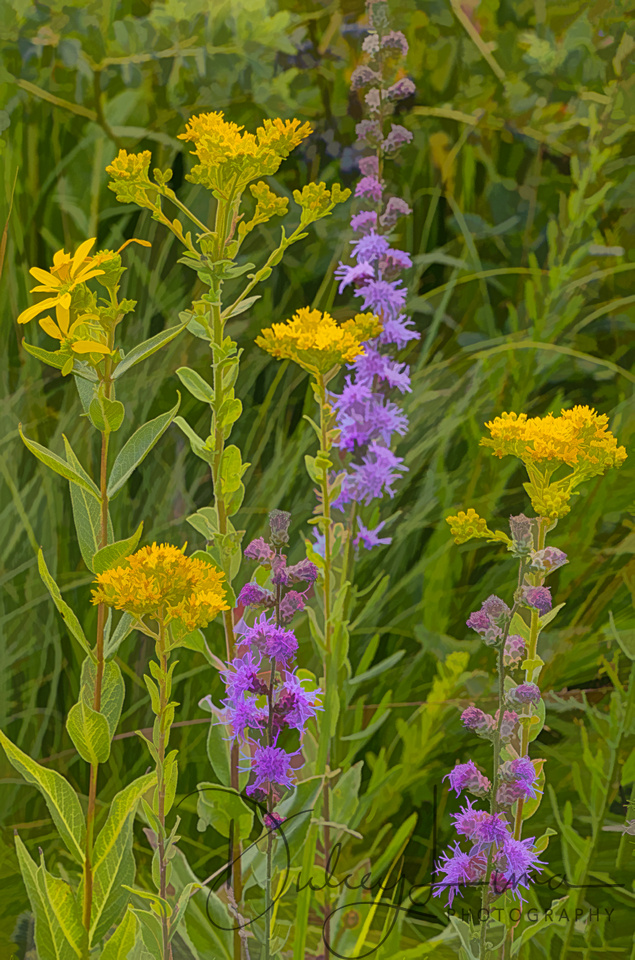
Goldenrod (Solidago rigida) and Purple Blazing Star (Liatris aspera) turn the prairie purple and gold in mid-August.

September ushers in the unmistakable blue flowers of Prairie Gentian (Gentiana puberulenta). It's a bloom worth waiting for as Summer drifts toward Fall.

Around the 3rd week in September, asters showcase their palette of mainly blue, purple and white flowers. Here, Blue Smooth Asters (Symphyotrichum laeve) and New England Asters (Symphyotrichum novae-angliae) create a stunning composition of purple petals with yellow and orange centers.
 Sunlight streams through the early morning fog, highlighting the tall seed heads of Indian Pale Plantain (Arnoglossum atriplicafolium) and grasses in the late Fall prairie.
Sunlight streams through the early morning fog, highlighting the tall seed heads of Indian Pale Plantain (Arnoglossum atriplicafolium) and grasses in the late Fall prairie.

Big Bluestem Grass (Andropogon gerardii) catches falling snow in the Wintery Schulenberg Prairie at The Morton Arboretum.

As Winter approaches, most prairie plants go into a dormant state. The roots pull water from the stems, leaves, and spent flowers above ground, and the deep roots of the plants continue to live on the stored nutrients. In Spring, these nutrients also provide the boost the plant needs to send up new shoots to begin the growth cycle anew.

And so the prairie regenerates itself, relying on light, water, nutrients, soil and seasonal temperature changes to create the beautiful palette of color and texture we look forward to each season.
]]>
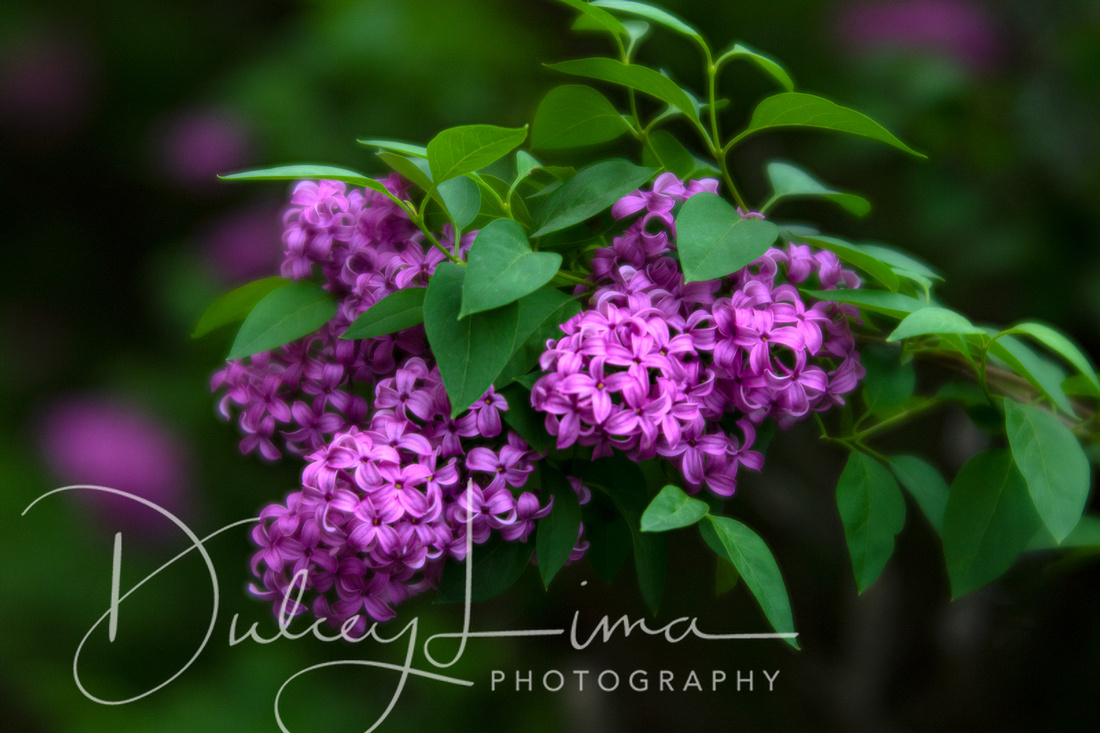
Springtime has always held a special place in my heart. My birthday is right on the cusp on the Spring Equinox and that timing signals that the days are getting longer, there’ll be more time to play outside, and everything is waking up. Spring crocus, daffodils, tulips, lilies of the valley and wildflowers begin popping up everywhere. Tree buds start swelling, displaying a hint of the green that is soon to dominate. Then, in early May, it is the lilac’s turn to take center stage.
I will forever associate lilacs with school at Divine Providence, where I spent 2nd through 8th grade. There, every classroom had a beautiful cabinet with closed shelves for books and other supplies. Built into the cabinet was an alcove that was just the right size for displaying a May altar.
In the Catholic Church, May is the month of Mary, the mother of Jesus, and at my schools, it was celebrated with great fervor. Special songs to Mary were sung every day (“Oh Mary, we crown thee with blossoms today. Queen of the Angels, Queen of the May”). Divine Infant School, where I attended first grade had a May crowning ceremony each year. I unexpectedly joined the special May crowing processional when my best friend, Linda Bubon, developed a sudden case of chicken pox. I excitedly stepped in as a willing understudy.
The students in every classroom at Divine Providence created a May altar. Aluminum foil usually lined the ceiling, floor and walls of the alcove, and a beautiful statue of Mary was placed in the middle of the altar. Students brought bouquets of flowers and placed them in vases around Mary’s statue and that’s where the lilacs came in to play.
Most every home had a lilac bush, or even a hedge of lilacs, that bloomed profusely in early May. Various hues of purple lilacs dominated the bouquets, with white and fuchsia varieties appearing in fewer numbers. The blossoms were so numerous, that every student, even in big Catholic families with 6 or 8 kids, could bring bouquets to school for the May altar without depleting the bush’s beauty.

The sweet, strong scent of the lilacs permeated the classrooms and halls. Each classroom had small, open out windows that provided the only ventilation on those hot, sticky, Midwest days. The smell of lilacs, mixed in with kids sweaty from running around on the playground, could be completely overpowering. When returning to school after the weekend, most of the tiny, lilac florets would have fallen around Mary’s feet, and new flower reinforcements would soon replenish the supply. Toward the end of the month, the bouquets would change to irises or peonies, carrying their own characteristic, sweet fragrance.
The sense of smell is more linked to memory than any other sense. This can happen subconsciously--catching a person off guard--when a whiff of something stirs a strong memory associated with that scent. When I smell lilacs each year, it brings me right back to those bouquets my Mom let me cut from behind the Kedzie’s garage, to decorating the May altar with girlfriends, and to late Spring days, when the temperatures were rising and summer vacation was just weeks away. Those are sweet memories, and ones I enjoy triggering each year as I approach a lilac bush and breathe deeply.
]]>
Visual and tactile textures provide details, assist us in separating one object from another and enhance our experience of the world. In photography, texture can visually add dimension and give the viewer an appreciation for a subject’s unique characteristics and appearance.

The bark of trees is rich in texture, and tree bark is one of the characteristics that scientists use to differentiate one tree from another. Intimate images of bark , leaves and other tree parts can expose beautiful patterns and details.



Beautiful plants like ivy climb up interesting surfaces like stone and brick walls, and ferns decorate the woods and rock walls with their finely textured fronds.


The feathers of birds provide ever changing patterns as the feathers and bone structure beneath them align in repose and in flight. Color, shape, size and position all contribute to the luscious texture and symmetry.





Old wood, twisted by the elements, or impacted by insects or animals, can reveal its history in a single cross section or fallen log. The viewer is left to imagine what forces contributed to its unique form and shape.



Rock faces, weathered, pitted or smooth, reveal their mineral components and the effect of nature’s magnificent forces.

Pebbles, rocks and boulders, smoothed or pocked by millions of years of crashing waves are deposited on beaches and distributed randomly, creating beautiful arrangements of color and texture.

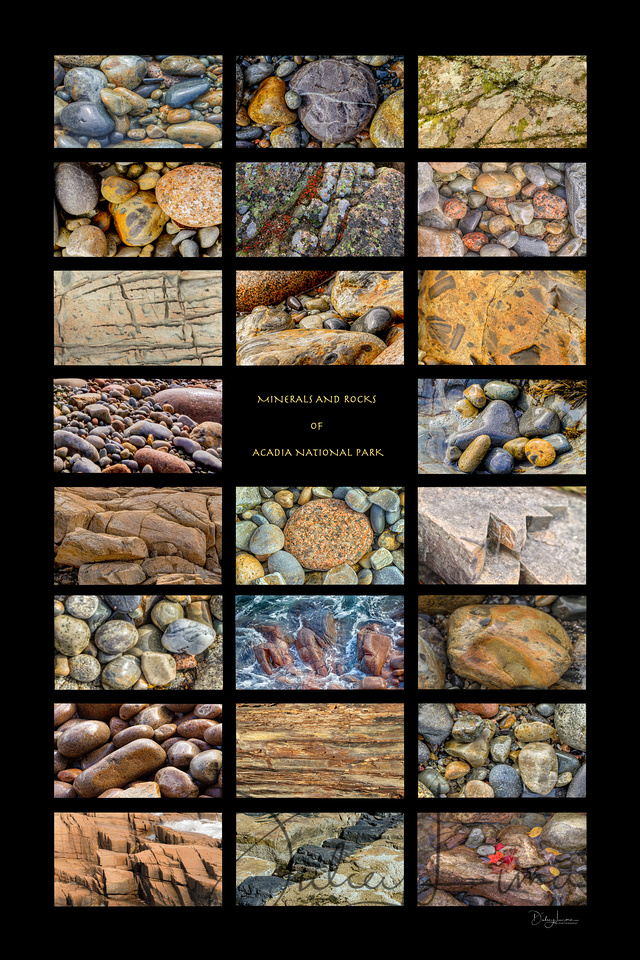
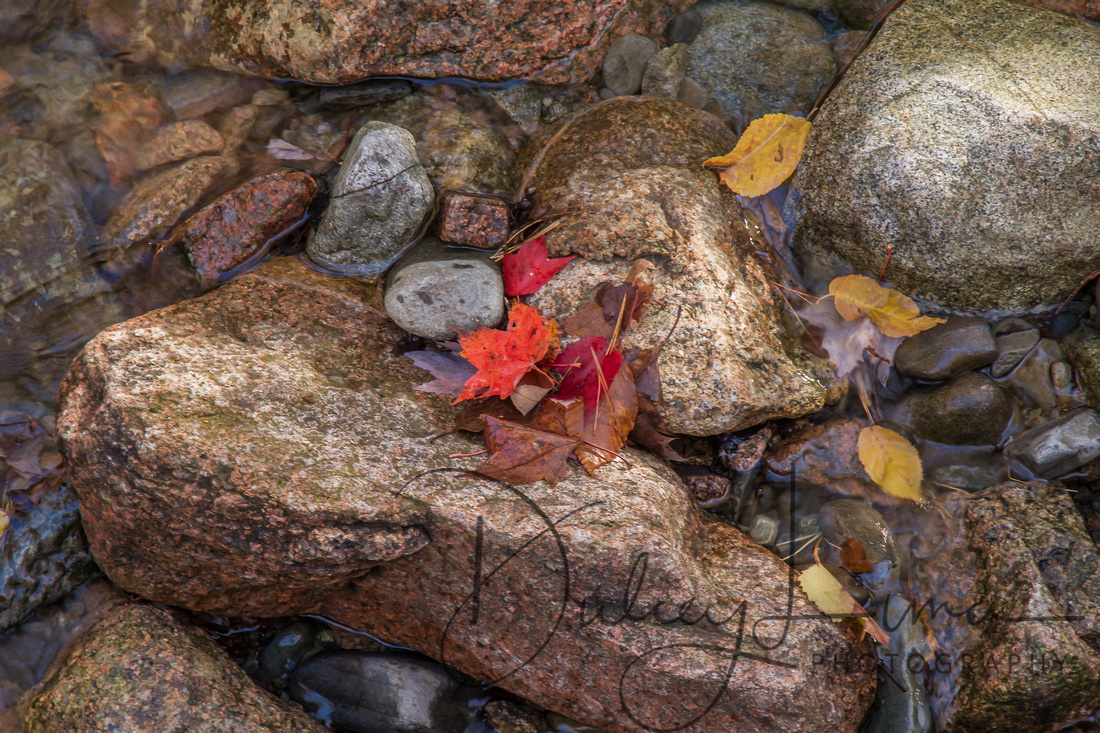
Flower petals and plants create a limitless array of textural photographic possibilities exhibiting attributes of soft, spiky, prickly, smooth, bumpy, silky, curly and wavy textures among others.



Animals who live in the oceans and on the beach provide an array of colors and textures that are unavailable in other ecosystems.


When texture is explored as a photographic medium, small details are revealed that can be overlooked in daily life, opening up new channels of discovery for the photographer and other visual explorers.
]]>
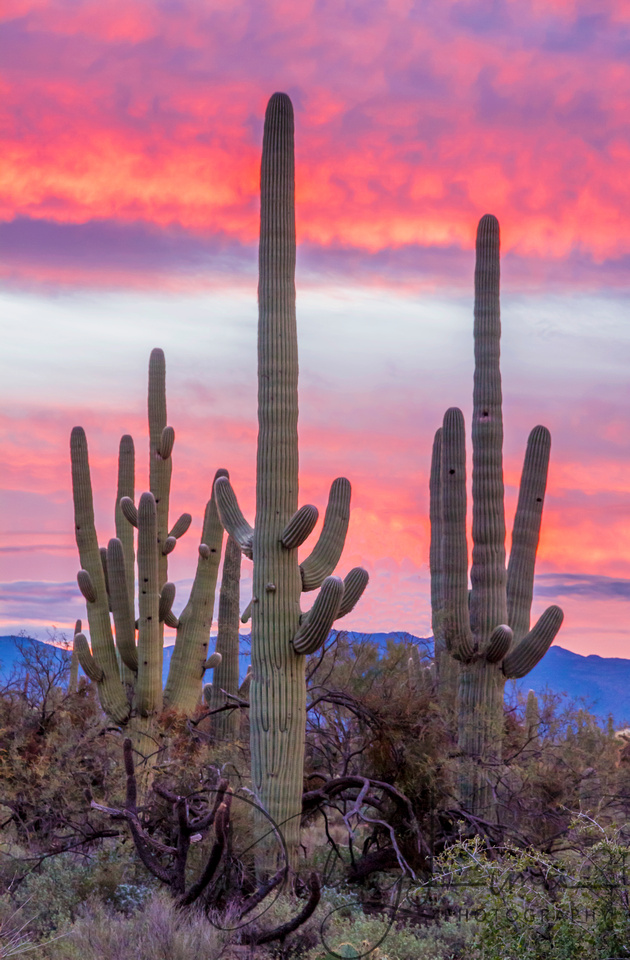
The majestic Saguaro Cactus, (Carneglea gigantean), is a living symbol of the Southwest and its bloom is the state flower of Arizona. Exceedingly slow-growing—a ten-year old plant is less than 2 inches tall! In adulthood it will tower over all the other plants of the Sonoran Desert and reach about 45 feet. All the growth occurs at the tips. By 70 years old a Saguaro can reach 6.5 feet and begin producing flowers. By 95-100 years a Saguaro Cactus can reach 15-16 feet and may start to produce its first arm. It reaches adulthood at about 125 years, and may live to be up to 200 years old. Saguaros don’t always produce arms, and when they do not, the Saguaro is called a spear. Arm buds normally emerge first at the greatest trunk or stem diameter. Since flowers are produced at the tip of each arm or stem, growing new arms increases the number of flowers and fruits, the likelihood of reproducing, and serves to ensure the survival of the species.
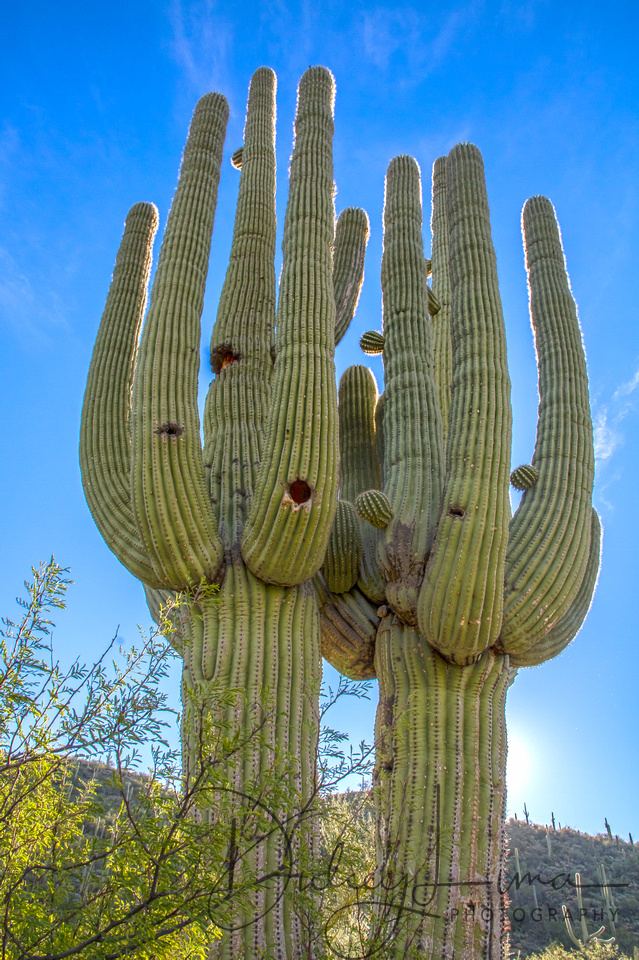
This thriving, dual stemmed Saguaro with a tremendous number of arms is likely 125-200 years old.
Occasionally the Saguaro takes a different form called a Cristate Saguaro. Theories for the Saguaro growing a crested or otherwise unusual shape vary between a genetic anomaly, freezing, or a lightning strike somehow affecting the growth pattern. Whatever the reason, Cristate Saguaros are sure to draw attention because although every Saguaro is different, Cristate Saguaros are rare and have very atypical growth patterns.
 The Cristate Saguaro Cactus on the left exhibits a fan shaped pattern with many arms. The Saguaro on the right is displaying typical growth.
The Cristate Saguaro Cactus on the left exhibits a fan shaped pattern with many arms. The Saguaro on the right is displaying typical growth.
Saguaros have a waxy skin that helps to prevent water loss, gives protection against predators, and protects against sunburn and freezing temperatures. Snow does fall in the Sonoran Desert but is generally short-lived in the Saguaro habitat. Saguaros can not tolerate temperatures below 23 degrees for longer than about 29 hours before freeze damage occurs, which can harm the arms of the cactus, causing them to drop downward.
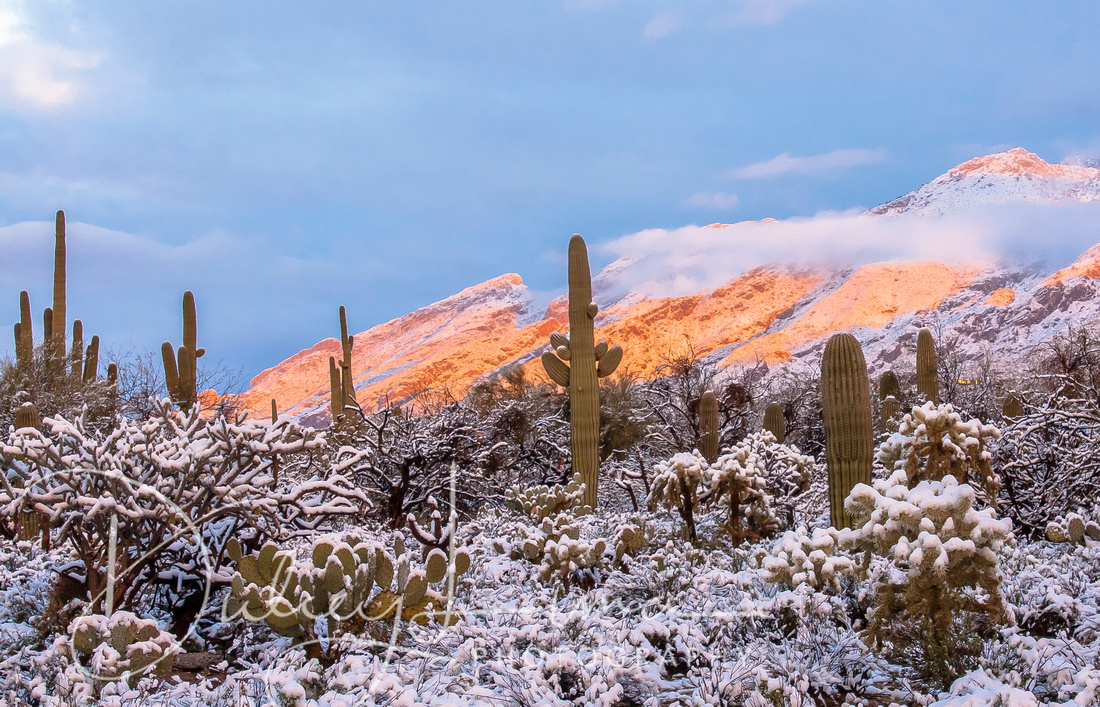
The interior is filled with a tissue which holds water like a sponge. To accommodate the potentially large influx of absorbed water, the pleats in the plant’s structure allow the cactus to expand like an accordion. When the desert is dry, the Saguaro uses its stored water to survive and the pleats contract.

Tufts of 2" spines are distributed evenly on every pleat on the main trunk and on every arm.
Since the majority of a Saguaro is made up of water, an adult cactus can weigh 4-6 tons or more. The enormous weight is supported by a circular skeleton of interconnected, woody ribs which correspond to the number of pleats on the outside of the plant. New ribs form by forking as the Saguaro grows, and the corresponding pleats follow the same pattern. The rib skeleton remains standing long after the cactus has died.

A Gilded Flicker perches on the ribs of a dead Saguaro cactus.
Along each vertical rib on the waxy exterior are 2” straight (not hooked) tufted spines with a felt like material in the center that provides shade and protection from freezing temperatures. The spines are also a barrier from hungry animals like mule deer, jack rabbits or big horned sheep who will resort to eating the fleshy Saguaro exterior in times of drought or limited food supply.


Beginning at the outside edge, the parts of the cactus are the spines, epidermis (green, waxy layer), cortex or pulp, ribs, and pitch (inside the ribs).
The Saguaro has one main tap root that can extend 2-5 feet underground to provide stability and absorb water from underground sources. In addition, it has a network of hairy roots that extend out from the base of the cactus as far as the Saguaro is tall. These roots specialize in water absorption and are only 3-5” below the ground. They take advantage of any rain that falls in the desert, even when there is fast runoff due to water and snow melt over the highly compacted desert soil. The superficial roots also wrap around rocks to provide stability, which is important, given the height, weight, and mountainous conditions in which the Saguaro grows. These roots can absorb up to 200 gallons of water during a rainfall, and help to withstand winds and overly saturated soil that can topple a water-laden Saguaro.
Saguaro flowers bloom at night during May and June and stay open until the following midday but not all of the creamy white, three inch flowers with yellow centers bloom at once. Each cactus averages about 4 open flowers a day for about 30 days. The primary night pollinator is the long-nosed bat who is attracted by the sweet scent of nectar and is perfectly suited given the high position of the substantial flowers that can withstand the bat’s weight. Daytime pollinators include honey bees, white winged doves, a variety of hummingbirds, orioles, woodpeckers, gilded flickers, verdins and house finches. As soon as the blossom is pollinated, it starts to set fruit.

Ladder-Backed Woodpecker

Broad-billed Hummingbird
If the fruit of the Saguaro is eaten by a coyote or cactus wren, the seeds pass through their digestive tract unharmed and are distributed throughout the desert in scat. But if the seeds are eaten by a dove or quail, they will be completely absorbed in their digestive system. Few seeds will survive to become a seedling, and fewer still will become an adult Saguaro. The low survival rate is attributed to drought, prolonged freezing, animals eating or stomping on the young seedlings and loss of nurse plant habitat. The three inch oval, green fruit ripens and splits open to reveal the red, pulpy flesh, appreciated by all desert animals. The Pima, Tohono O'odham and Papago Indians dried, fermented, canned and stored the fruits and used the seeds for flour and porridges.
Saguaro seedlings benefit from growing under “nurse trees” which are usually Mesquite, Palo Verde or Ironwood varieties. The trees provide shade and protection from predators and freezing temperatures. The branches of these trees also provide stability to the young Saguaros whose root system is not well developed, and often the cactus will be wrapped gently within a branch of the tree. The Saguaro generally outlives the nurse tree, given that most Saguaros survive 1-2 centuries.

A Mesquite "nurse" tree shields two nearly identical Saguaros at Sabino Canyon.
Saguaros are characterized as foundation species because they support so many other species in the ecosystem. Despite their sharp spines, Saguaros serve as “hotels” for birds like Gila woodpeckers, which carve out nest holes in the plants. The Saguaro “heals” the holes by creating a solid, internal casing around the cavity, which also provides a perfect nest inside the cactus. Called cactus “boots”, these internal structures were also used by Native Americans as containers for water and food.

An opening in the woody skeleton of a dead Saguaro reveals a number of "cactus boots" which developed after woodpeckers excavated nesting holes.
Since flickers and Gila woodpeckers create new holes every year, other birds like elf owls, house finches, fly catchers and purple martins move in to the pre-owned nest. Red tailed hawks and other large birds nest in the intersections between the main stems and arms. These holes do not appear to be problematic for the Saguaro given its ability to wall off external holes created by birds or insects. Freezing temperatures, lightening or overwhelming mechanical damage are the biggest threats to a Saguaro’s survival once it has become established. Even Saguaros struck by lightning or “decapitated” by the wind or other force can sometimes continue to grow new arms, bloom and survive.
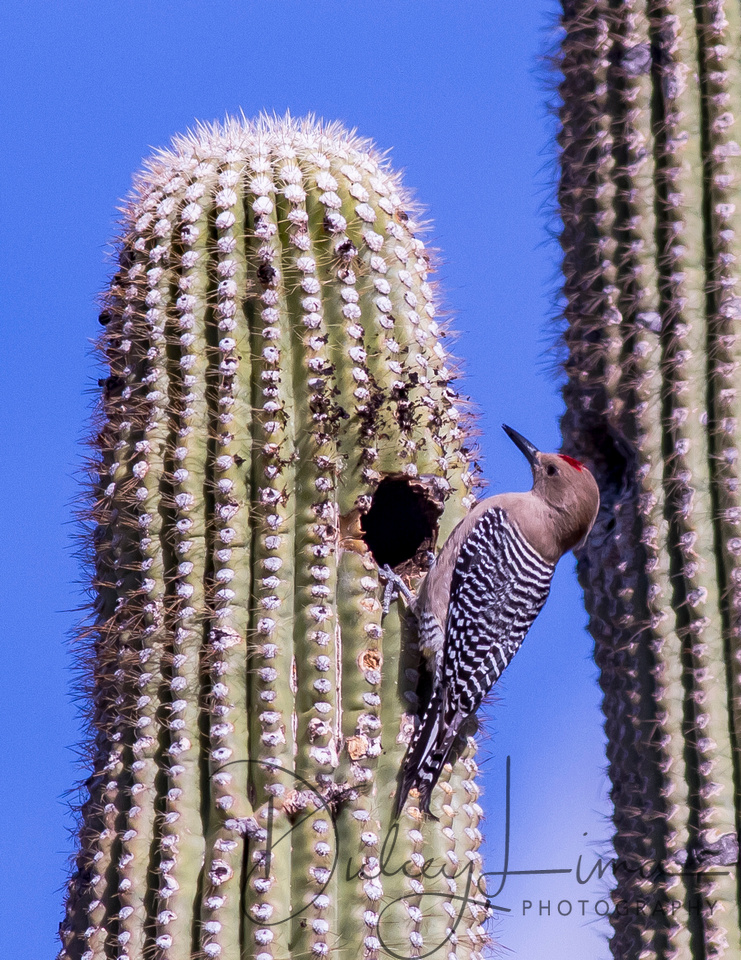

A Gila Woodpecker peaks out of his Saguaro home.
The Saguaro’s strong architectural form, ability to survive climate extremes, remarkable variances in shape and proximity to beautiful mountain ranges and desert have earned it a special niche in the American Southwest. It is a symbol and sentinel of the Sonoran Desert, a plant to emulate for its adaptability and strength, and a reminder that even under the harshest conditions, the desert is an interconnected network of animals, plants and other organisms that thrive in their unique location on planet earth.

For more information about Saguaro Cactus, check out these webpages that I used to gather the information for this blog.
https://www.nps.gov/sagu/learn/nature/saguaro_roots.htm
https://www.nps.gov/sagu/learn/nature/how-saguaros-grow.htm
https://www.sciencefriday.com/articles/11-things-you-didnt-know-about-saguaro-cacti/
https://www.fs.fed.us/wildflowers/plant-of-the-week/carnegiea_gigantea.shtml
https://www.desertmuseum.org/kids/oz/long-fact-sheets/Saguaro%20Cactus.php
https://www.desertusa.com/cactus/saguaro-cactus.html
https://en.wikipedia.org/wiki/Saguaro
https://www.nps.gov/sagu/learn/nature/why_pleated.htm
https://www.nps.gov/tont/learn/nature/saguar
https://www.nps.gov/sagu/learn/nature/saguaro_reproduction.htm
https://www.fs.fed.us/database/feis/plants/cactus/cargig/all.html
http://npshistory.com/series/science/17/saguaro-ecology-3.pdf
]]>

The Brown Pelican, Pelicanus Occidentalis, is a large, coastal sea bird characterized by a large bill, thin neck, webbed feet and large (gular) pouch. Unlike all other pelicans, the Brown Pelican can plunge dive from 30 feet above the water, using the force of impact with the water to stun the fish. As it hits the water, the throat pouch expands to trap the fish, filling it up with about 2 ½ gallons of water. It then tips its head down to drain the water from its pouch, and tosses its head back to swallow the fish. This action is both dramatic and comical, which makes watching pelicans a favorite pass time of beachgoers. Brown Pelicans can spot a fish from as high as 65 feet, and they eat about 4 pounds of fish per day. They are gregarious birds and nest in colonies, usually in mangroves on isolated islands in South Florida or in small trees. They often fly and fish in a straight line or next to each other along the shore.
During a dive, the Brown Pelican tucks its head, folds its wings back and rotates its body to the left as it enters the water. They may turn left to cushion their trachea and esophagus which are located on the right side of their bodies. Air sacs in the bones and under the skin make them buoyant, cushion the impact when plunging and help them rise quickly to the surface.
Brown Pelicans are the smallest Pelicanus in the family, but they are still large birds, with bodies 40-54 inches long and a wingspan of 7-8 feet. Adults weigh about 8 pounds and have gray and brown wings, yellow heads and white necks and breasts. Their head feathers turn a russet color when breeding. Juvenile Brown Pelicans have grayish brown heads and bodies and are nearly the same size as the adults by the time they fledge from the nest at about 71-93 days. They reach full maturity at 3-5 years old. Female and male Pelicans have nearly the same markings with females being slightly smaller. Adult Brown Pelican eyes have a blue iris, which changes to brown during the breeding season.

In flight, Brown Pelicans flap their wings a few times-- then glide, surfing high and low on the updrafts along the waves. If the fish are plentiful in shallow or muddy water, they sometimes feed by sitting on the water’s surface, lurching forward to seize the prey with their bills. This is also the hunting strategy typical of all other types of pelicans.
Brown Pelican populations are now very stable, thanks to decisions made through the Endangered Species Act and the Environmental Protection Agency. Pelicans were listed as endangered in 1970 due to exposure to DDT that was found to thin their eggs, resulting in reproductive failure. In 1972, the EPA banned DDT, and Brown Pelicans began to recover. In 2009, the Brown Pelican was delisted as an endangered species and their numbers have again returned to healthy levels. Birds of prey such as Bald Eagles or Hawks have been known to eat the eggs of Pelicans, and toxins in the water or in the fish the Pelicans eat can make them ill. Nest disruption by people can also have a negative impact on population numbers. Pelicans stand on their eggs to keep them warm, and when humans come too close to the nest or scare the parent bird away, the Pelican's feet can contract reflexively and crack the shell. Fishing line and hooks also pose threats to Pelicans because at times the Pelicans are going after the same fish as the fisherman, resulting in a Pelican swallowing a hook in the process.
Brown Pelicans give photographers a fighting chance to capture a good picture because they can be seen from a distance, providing both time and opportunity to get the bird in focus. Their wings do not flutter quickly like those of tiny birds, and their distinctive features and behavior make practicing fun. They can look like prehistoric cartoons as they bank and suddenly hurl themselves down into the water.
It is always a treat to see them throw their heads back to swallow their catch.

A 100-400 mm zoom lens is very helpful because Pelicans are large, powerful flyers and can get close so quickly, that it can be difficult to get the entire bird in the frame with a fixed lens. Experiment with different ISO settings, and don’t be afraid to try a higher ISO than you would ordinarily use so you can stop the action of the wings in flight. Most of my images of pelicans were taken with an F stop of 5.6 and an ISO of 640. Shooting around sunrise or sunset when the sun is lower on the horizon provides the best illumination, particularly if the Pelican is flying towards the sun. When flying away from the sun, the Pelican’s large wings often shade its eyes and head, causing a loss of detail.

Whether you photograph Brown Pelicans in the air or bobbing on a shallow pond, they are sure to provide plenty of opportunities for learning, laughing and capturing some memorable images.
Sources:
http://www.audubon.org/field-guide/bird/brown-pelican
https://www.allaboutbirds.org/guide/Brown_Pelican/id
https://nationalzoo.si.edu/animals/brown-pelican
https://en.wikipedia.org/wiki/Brown_pelican
]]>Sometimes the temperatures of Labor Day weekend would send people back to work and school with sunburned faces and shoulders, and other times it was too cool to enjoy the last swim of the summer. No matter what, the changing temperatures were a signal that the leaves would soon be changing color and Fall was imminent. I think the brilliance of trees in the Fall is the present we receive for losing the lovely, warm days of Summer. The Sumac leaves in the image attached to this blog post are some of the first to transform their color each year, announcing that change is upon us.

Multiple variables interact to produce the Fall color display each year. According to the U.S. National Arboretum, during the Spring and long days of Summer, chlorophyl is constantly replaced in the leaves, giving them their green color and storing the nutrients they will need for the next year. As the nights get longer in the Fall, the cells near the intersection of the stem and leaf divide rapidly but do not expand, creating a layer called the abscission layer. This layer blocks the transport of nutrients from the leaf to the branch and from the roots to the leaves. Since there is no transfer of materials, the chlorophyl gets blocked from the leaves and the green pigment disappears, which makes the yellow and orange colors more visible. Red and purple pigments from the sugars are trapped in the leaf and together this change results in vivid, Fall color. As Autumn progresses, the cells in the abscission layer become dry and corky, causing the leaves to break off from the stem and fall.
According to accuweather.com, cool air at night with abundant daytime sun increases the formation of more red and purple pigments, but freezing conditions destroys the leaf's ability to manufacture them. Early frost puts an end to the colorful foliage. If there is a drought during the growing season, the abscission layer forms early and causes the leaves to drop before they change color. Heavy wind or rain can also cause early leaf drop and a less than spectacular display. The Emerald Ash Bore Beetle has reduced the numbers of White and Green Ash trees known for their spectacular Fall color, so there is a reduction in the diversity of species in our communities and forests that used to add depth and variety to the color palette. All of these factors combined determine the kind of color we'll see each Fall.
What are the perfect conditions for beautiful Fall leaves? Brilliant Fall foliage requires a growing season with ample rainfall and a dry, cool and a sunny Autumn with warm days and cool, frostless nights.
Cooler temperatures create wonderful walking and hiking conditions, perfect for a stroll through one's neighborhood, forest preserve or arboretum. Summer is behind us, but there are still several weeks left to enjoy brilliantly colored leaves and nature's abundant gifts.
]]>
 People start to smile when they see a Sunflower field in full bloom. Whether it's the height of the flower at 5-12 feet, the huge size of the flower head, or the sight of row after row of beaming sunshine, most people are captivated by them. They have relatively little fragrance and a rather bristly stem, but at this time of year they are one of the most popular cut flowers at Farmer's Markets and gardens. It's nearly impossible to drive by a Sunflower field in full bloom without stopping to take a picture, so what's the best way to capture a shot that truly reflects the charm and beauty before you? I've pulled together some strategies for shooting these phenomenal blooms for this blog post.
People start to smile when they see a Sunflower field in full bloom. Whether it's the height of the flower at 5-12 feet, the huge size of the flower head, or the sight of row after row of beaming sunshine, most people are captivated by them. They have relatively little fragrance and a rather bristly stem, but at this time of year they are one of the most popular cut flowers at Farmer's Markets and gardens. It's nearly impossible to drive by a Sunflower field in full bloom without stopping to take a picture, so what's the best way to capture a shot that truly reflects the charm and beauty before you? I've pulled together some strategies for shooting these phenomenal blooms for this blog post.
When to shoot: In Northern Illinois, Sunflowers are usually in peak bloom between the 2nd and 4th week in July. Weather conditions at the time of planting can have a tremendous impact on when the flowers bloom and how intact the field will be. The tall plant stems are thick and strong, but heavy rain and wind can drive the flower heads down and crack the stem right below the flower. It's best to keep an eye on the field beginning around the 4th of July if you live close enough. If the field is far away, and the field is planted on a farm open to the public or on public land, try calling the office to get a bloom report. Just a few days one way or the other can make the difference between Sunflowers that are upright and pointed straight ahead or droopy and on the decline. Bloom time lasts about three weeks from the time the buds begin to open to the point at which the heads drop. As the flowers get past peek bloom, the seeds mature and gravity begins to pull the flower heads down. At this point instead of light little bees flitting around on the flower head, the flowers get visited by squirrels, birds, and other critters, and who can blame them? The seeds are delicious! Insects can also nip at the leaves, leaving behind holes and ugly foliage. So--keep an eye on the Sunflower field and also note its placement in relationship to where the sun will rise and set. Here's a link to a blog about how photographer Ryan Heffron planned a lovely photoshoot of Sunflowers beneath the Milky Way: https://petapixel.com/2016/09/26/captured-field-sunflowers-blooming-milky-way/#disqus_thread
What shots to take: It can be intimidating to look around and see all this beauty, then wonder--where do I start? Searching Sunflower images online can help you determine which views you would like to incorporate into your shoot. It's likely you'll want to take both landscape and macro shots, as each type of photography will provide a different perspective. Use a tripod when possible, and don't be afraid to bump up your ISO if you have windy conditions, particularly if you have decent light. Some shots will require you to go off tripod in order to get a difficult angle, but in general, stay on your tripod.
Landscape: Include foreground interest, middle ground and background to capture the depth of the field. The sky is nearly as important as the Sunflower field, and depending on the conditions, can create drama, playfulness (puffy clouds), or can include a sunset or sunrise. You may have to get down low in order to use the sky to your best advantage. If your Sunflower field has distinct rows, find a row that has good looking flowers, possibly with blooms in different stages or in different heights to help provide interest and fill the middle ground of your image. Taking a landscape image of the backs of the sunflowers can also be very interesting.
Macro: It seems like every part of this flower is photogenic. Find small details like an unusual curve in a petal or leaf, a bee collecting pollen, the spiral patterns of the seeds, or the back of the flower.

Pay attention to your background and depth of field. Depth of field is a challenge with Sunflowers because they are everywhere, and can make a shot look cluttered. Consider using a shallow depth of field, using the surrounding Sunflower coloration to enhance your subject rather than compete with it.
Portraits: Every Sunflower is a little different, and you may be lucky enough to find a field where some of the flowers are just beginning to open. The petals open in sections, and they often appear to be shyly covering up their centers, or hiding their "faces". Portraits and any other type of shot can be enhanced with back lighting, which makes the petals glow and the centers stay dark in contrast. Get low again to isolate a bloom against the sky, being careful to monitor your exposure if you have a great blue sky and/or clouds to shoot against. You will probably need to go off tripod for that.
High Definition Range (HDR): Shooting 3 images of the exact same shot with three different exposures: Normal, Bright, and Dark, can be very effective, particularly if you have a good sky to work with or are shooting at sunset or dawn. HDR allows you to capture the full range of light that your eyes see, but your camera does not capture if only one image is taken. HDR requires special software, for example Photoshop or Photomatix among others. The three images are blended together to create a dramatic image.
Photo stacking: I haven't been successful with photo stacking for Sunflower fields. Photo stacking involves using manual focus and taking multiple shots of exactly the same image by changing where you focus your lens on the subject. Sunflowers are seldom completely still, which is a requirement of this technique because software will be used later to stack all the images on top of each other to ensure that every single part of the image is in focus. Any shift in the flower position between images creates shadows and "ghosting", and makes aligning the images difficult if not impossible. If you happen to have a very still day, give it a shot. Otherwise, spend your time on some other great shot.
Clothing: Sunflower stems, leaves, and flower heads are all hairy and somewhat bristly. I always wear long pants and a long sleeved shirt to protect my arms and legs. There are often weeds between the rows that you will be wading through, so closed shoes and socks will help protect your feet. Mosquito repellent is always recommended at this time of year in the Midwest, and water and a hat will help keep you a bit cooler. Sunflowers thrive in hot, summer temperatures, so it's great if you can get out early or later in the day when the light is best and the temperatures will not overheat you.
Where to find Sunflower fields: Two fields within 80 minutes of the Chicago suburbs are a field planted at Desplaines Valley Fish and Game in Wilmington, IL, and one planted at Mathieson State Park near Starved Rock.
Desplaines Valley field: From Chicago, take Rt. 55 South to exit 241. Turn left at the top of the ramp. Drive about 3 miles until you see the orange snow fence with the sunflowers behind it. This year the field had a rough start with weather, so it was not as "organized" as it has been in other years. Still, it had great opportunities for taking Sunflower portraits. You will have to crawl through a fence to get to the field, and there is very limited parking in a small driveway up to the fence.
Mathieson State Park: From Chicago, take 55 South to exit 250B for I-80 West toward Iowa. Take exit 81 for IL 178 toward Utica/LaSalle. Turn left onto IL-178S/E8th Rd. Continue on 178 south of 71 to the RIVER entrance. Drive the road back and around to the signs to the model airplane field. You'll curve around, turn into the parking lot and you'll see a beautiful field of sunflowers. This year they were peaking on July 25th, and Mathieson State Park published information about it on their website.
Two more Midwest sites I've heard about this year but have not been to yet are Pope Farm Conservancy in Middleton, WI and L and A Family Farm in Paris, IL (which also has a Sunflower maze). Community gardens are also great places to photograph sunflowers. Although these gardens do not have large fields, there is great opportunity for photographing Sunflower portraits.
Search online for Sunflowers with your zip code or geographic area to find other Sunflower fields near you. While people can sometimes be very secretive about their location, most folks are willing to share their spots with you if they know you will be very respectful of the site. Do you have a favorite Sunflower field you'd like to share? Please feel free to leave the location in the comment section.

Enjoy!
Take care,
Dulcey
]]>
Last year, my daughter Sarah and I published our first book of photos and verse entitled Animals Among Us, which is available at your local, independent book store like Women and Children First in Chicago: http://www.womenandchildrenfirst.com/book/9780997510201 or on Amazon at https://www.amazon.com/Animals-Among-Us-Dulcey-Lima/dp/099751020X/ref=sr_1_2?ie=UTF8&qid=1499203196&sr=8-2&keywords=animals+among+us. Ever since, I’ve been wanting to begin another photography based project to highlight local sights, National Parks, and some of the special places we’ve visited across the world. While my passion is photography with a focus on the natural world, I also love capturing the intimate details of objects and of course taking pictures of our Granddaughters, family and friends.
It’s wonderful when someone likes our book or my photographs enough to purchase one for their own home. I have been fortunate to have sold several of my landscapes and close up/macro images at art shows and it is always a thrill. I have also enjoyed using the images as greeting cards and calendars over the years and thought that having a website would provide others with the same opportunity to use the images for their own projects.
If you have a few moments, please check out my zenfolio website. I hope you will enjoy the images, and if by chance you would also like to purchase any of them, that option is available in everything from 4x6 pictures, cards, coffee cups, to large canvas or framed prints. Feel free to leave me any feedback you have—including suggestions for how I can improve the visitor experience.
All the best to you!
Thanks,
Dulcey
]]>

